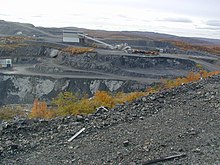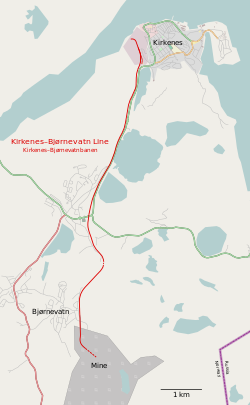Kirkenes–Bjørnevatn Line
| Kirkenes–Bjørnevatn Line | |||
|---|---|---|---|
AMSL | |||
| |||
The Kirkenes–Bjørnevatn Line (
The line was built by the mining company
Route

The Kirkenes–Bjørnevatn Line is 8,484 meters (27,835 ft) long and runs from Bjørnevatn Mine to Kirkenes Port. While the line had passenger transport, it had two stations,
Starting at Bjørnevatn, the railway line starts underground at a silo, 77.0 meters (252.6 ft)
The railway then runs under
History
Construction
Iron ore was discovered at Bjørnevatn in 1866.[2] The ore was of poor quality, but lay close to the surface—allowing for open-pit mining, had large deposits and was located close to a port. The mining company Sydvaranger was established by German and Swedish investors in 1906. A separation plant was built in Kirkenes and the company decided to transport all ore from the mine to the port by rail. Inge T. Wiull, former manager of the Valdres Line, was hired as divisional leader for the construction of the railway, the port and the residential areas.[2]
Construction of the railway was given high priority to as early as possible aid in transport of workers to the mining sites. Both stations were completed in 1908, the same year as the laying of tracks started. The line originally had a
Mining started on 7 July 1910, with the first ore train being run on 13 July.[2] The first shipload left Kirkenes on 11 October, but SS Bengal sank with the first shipment. In 1911, the system exported 330,000 tonnes of ore.[2] The railway was also used for transporting workers, with trains running from the towns to the plants in the morning and returning after the working day was over. Prior to private cars becoming common, the railway operated a passenger carriage on the trains between Kirkenes and Bjørnevatn—allowing free travel. The railway has never had any scheduled or public transport of passengers, but the company's concession specifies that the authorities could at a later date require the company to operate public passenger services under specified conditions.[2]

Electrification
In 1910, construction started of an electric power supply for tracks at the port. Originally it had 500 volts
The original system was designed for an export capacity of 650,000 tonnes (640,000 long tons; 720,000 short tons), and in 1913, the company exported 427,000 tonnes (420,000 long tons; 471,000 short tons) and had 1,150 employees.
In the 1920s, the economy fell into a low conjuncture, forcing Sydvaranger to file for bankruptcy in 1925. However, the facilities were quickly reopened.[2] Two new Bo-locomotives, which could operate both on the mainline and at the port, were delivered in 1930. Built by Siemens-Schuckert, they were christened Lisa and Sonja. Two mainline Bo'Bo' locomotives were delivered by Siemens-Schuckert in 1935, which were named Oscar and Ivar. They were followed by the Bo Laila and Gerd two years later—which could operate both on the mainline and at the port.[3] During the late 1930s, the railway company started replacing the rails with heavier 35 kilograms per meter (70 lb/yd) rails, although this work was not completed.[2] The final electric locomotive was a Siemens-Schukert-built Bo unit delivered for the port in 1940.[3] In 1938, the last year before production was reduced because of the Second World War, the mine exported 900,000 tonnes (890,000 long tons; 990,000 short tons).[2]
Occupation and reconstruction
After the

As part of Operation Nordlicht, Kirkenes was scorched, causing extensive damage to the mining company's infrastructure. During the reconstruction, Sydvaranger needed to transport large machinery to Bjørnevatn, so the loading gauge was increased to 6 meters (20 ft). All heavy transport during the reconstruction was done using railway, and tracks were laid throughout the mining facility. From 1945, passenger trains ran between the two settlements, at first with steam locomotives, and from 1950 with electric locomotives. New storage silos were built in Bjørnevatn, but from operations started, transport within the mine was performed using trackless machinery. A new port facility was built in Kirkenes, with the line terminating at the Air Bridge, an elevated railway which led to the plant. Mining operations and revenue service on the railway did not start until 1952.[2]
The
To allow for larger trains, the permanent way was upgraded. The rail profiles were upgraded to 49 kilograms per meter (78 lb/yd), were

In 1980, the mine's production peaked with an export of 2.4 million tonnes and 1,000 employees.
Reopening
Arctic Bulk Minerals bought the mining rights, and operated a train once to twice a year to keep the track and rolling stock maintained. This company filed for bankruptcy in 2002.
To haul the trains, the mining company took delivery of a
On 18 November 2015 the mining company went into bankruptcy.[13]

Expansion
In the
Since 1992, there have been proposals to extend the Kirkenes–Bjørnevatn Line to either
In 2003, the cost of the necessary 40 kilometers (25 mi) of new railway was estimated at 1.4 billion Norwegian krone (NOK), while the cost of upgrading the existing Russian line was NOK 400 million.[17] In 2007, Murmansk Oblast's governor, Yury Yevdokimov, rejected the plans for a connection to Russia, stating that his opinion was supported by President Vladimir Putin. Because Kirkenes is a better suited port than Murmansk, local authorities in Murmansk do not want to lose transshipment business to Norway.[18] However, with the increased realism of a line to Rovaniemi, which would serve as an alternative route to Kirkenes from Russia, Russian authorities have since 2010 again supported a railway line between Kirkenes and Russia.[19][20]
A prestudy also exists about the possibility to connect Kirkenes to the
References
- ^ ISBN 82-90286-15-5.
- ^ a b c d e f g h i j k l m n o p q r s t u v w x y Bjerke, Thor; Jerijervi, Ørjan (2003). "Aktieselskabet Sydvarangers jernbane". Ottar (in Norwegian). 244. Tromsø: University of Tromsø: 32–39.
- ^ ISBN 82-91448-42-6.
- ^ Norwegian Broadcasting Corporation (in Norwegian). Archivedfrom the original on 22 June 2012. Retrieved 20 February 2012.
- ^ "EMD G12 Sydvaranger" (in Norwegian). Jernbane.net. Archived from the original on 2 August 2012. Retrieved 20 February 2012.
- ^ "MaK G 1200 Sydvaranger Jernbane" (in Norwegian). Jernbane.net. Archived from the original on 2 August 2012. Retrieved 20 February 2012.
- ^ Bjørhei, Randi (31 January 2011). "Dom i Høyesterett: Eiendomsskattetakst" (in Norwegian). Lovdata. Archived from the original on 21 September 2016. Retrieved 20 February 2012.
- ^ "Malm for 100 milliarder". Finnmarken (in Norwegian). 17 March 2008. Archived from the original on 5 February 2009. Retrieved 20 February 2012.
- Barents Observer. Archivedfrom the original on 15 January 2010. Retrieved 20 February 2012.
- Barents Observer. Archivedfrom the original on 20 February 2012. Retrieved 20 February 2012.
- ^ "Fahrzeugportrait Vossloh 5001852" (in German). Loks-aus-Kiel. Retrieved 20 February 2012.
- ^ "Locomotive delivered for north Norway reopening". Railway Gazette International. 11 March 2010. Archived from the original on 4 November 2012. Retrieved 20 February 2012.
- ^ Sør-Varanger Avis A/S. "Sydvaranger Gruve er konkurs". sva.no. Retrieved 21 August 2016.
- ISBN 82-9144-800-0.
- ^ Ellingsve, Arvid (1995). Nordlandsbanens krigshistorie (in Norwegian). Oslo: Norwegian State Railways. p. 22.
- ^ "Kirkenes RailPort May 2003" (PDF). World Port Kirkenes. 2003. pp. 27–33. Archived from the original (PDF) on 7 February 2012. Retrieved 20 February 2012.
- ^ "Både norsk og russisk næringsliv ønsker seg en jernbane mellom Nikel og Kirkenes, et prosjekt som kan beløpe seg til 1,4 milliarder kroner". Finnmarken (in Norwegian). 17 September 2003. Archived from the original on 17 December 2005. Retrieved 20 February 2012.
- Norwegian Broadcasting Corporation (in Norwegian). Archivedfrom the original on 20 February 2007. Retrieved 20 February 2012.
- ^ "Murmansk port faces foreign competitors". Barentsnova. 20 September 2011. Archived from the original on 9 October 2011. Retrieved 20 February 2012.
- ^ "Обходят с севера". Rossiyskaya Gazeta. 20 September 2011. Archived from the original on 9 October 2011. Retrieved 20 February 2012.
- ^ "Jernbane Kirkenes — Rovaniemi?". Finnmarken (in Norwegian). 4 September 2009. Archived from the original on 7 September 2009. Retrieved 21 February 2012.
- ^ a b "Arctic Ocean Railway Report" (PDF). 9 March 2018.
- Sør-Varanger Municipality. Archived(PDF) from the original on 4 March 2016. Retrieved 20 February 2012.
- Norwegian Broadcasting Corporation (in Norwegian). Archivedfrom the original on 22 September 2012. Retrieved 21 February 2012.

